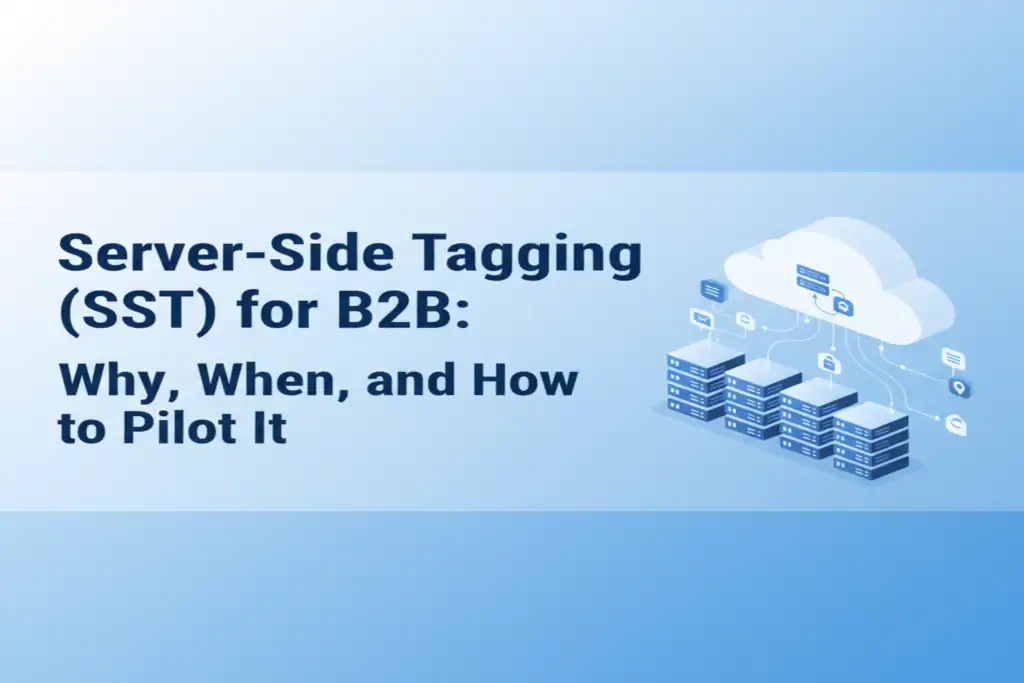Third-party cookies are fading, and client-side pages keep getting heavier. Server-side tagging (SST) routes measurement through a secure server container, improving page performance, data quality, and control.
This guide explains when SST makes sense for B2B, what changes in your setup, and how to run a safe pilot before scaling.
Let’s unpack the why, when, and how.
1. What Server-Side Tagging Is (in Plain English)
- Instead of the browser talking to every ad/analytics vendor, the browser sends one request to a first-party endpoint (your measurement server).
- The server then forwards data to vendors (GA4, Google Ads, Meta, LinkedIn) with better reliability, mapping, and consent enforcement.
- You still design events in GTM, but a second GTM container (server) handles vendor delivery.
2. Why B2B Teams Consider It
- Performance → fewer client-side scripts and network calls improve LCP and INP.
- Data control → normalize parameters, strip PII, and enforce consent server-side.
- Resilience → higher hit delivery under adblockers and poor networks.
- Identity → enables first-party tagging and enhanced conversions pipelines (Meta Conversions API).
3. When You Probably Don’t Need SST (Yet)
- Low-traffic sites with no paid media complexity.
- Sites with only basic GA4 tracking and no consent requirements.
- Teams with limited engineering budget to maintain a server endpoint.
4. Architecture at a Glance
- DNS → CNAME a subdomain (e.g., tags.yourdomain.com) to your server container.
- Client → Web container collects events → sends to server endpoint.
- Server → Server container maps events → routes to GA4/Ads/etc. via vendor templates.
5. Pilot Plan (2–3 Weeks)
Week 1: Prep
- Pick a single property/brand to pilot.
- Define 3–5 core events: page_view, cta_click, form_submit.
- Stand up GTM Server (App Engine, Cloud Run, or AWS).
- Set a first-party subdomain.
- Mirror current GA4 delivery: web container → server container → GA4.
Week 2: Parallel Run
- Keep client-side GA4 active for comparison.
- Route an A/B split (or subset of pages) through SST.
- Validate parity in event counts, parameters, and conversions.
Week 3: Evaluate and Decide
- Compare delivery rate, LCP/INP impact, and ad platform match rates.
- If parity + performance improve → expand routing and add additional vendors (Google Ads, Meta).
6. Cost and Maintenance
- Cloud costs are usually small at first, then scale with traffic (Google Cloud Run pricing).
- Expect ongoing upkeep: template updates, consent logic, identity mapping, QA.
7. Risks to Manage
- Misconfigured mappings can drop parameters → use a regression checklist.
- Consent enforcement must be consistent across web + server containers.
- Over-collection risks compliance → strip PII at the server layer.
Final Thoughts
Server-side tagging won’t be necessary for every B2B site. But for performance-sensitive or paid-media-heavy teams, it can significantly improve accuracy and control.
Start with a contained pilot, measure the impact, and only scale if it clearly outperforms your current setup.
👉 Want a pilot architecture tailored to your stack? Book a free consultation.
Need help implementing GA4, GTM, or KPI restructuring?
Schedule free consultation
